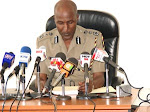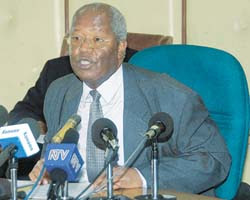 The Human Rights Watch has released their report on the post-election violence in Kenya. As expected, they have mentioned the aspect of organised crime. But who are the organizers/funders of those goons who ran amok in Nakuru and Naivasha killing innocent Kenyans. Who gave money to Mungiki and how much was it?
The Human Rights Watch has released their report on the post-election violence in Kenya. As expected, they have mentioned the aspect of organised crime. But who are the organizers/funders of those goons who ran amok in Nakuru and Naivasha killing innocent Kenyans. Who gave money to Mungiki and how much was it?
The report is quoted elsewhere as saying, and we reproduce the summary here:
In the Rift Valley, where Kikuyus were attacked, the violence was meticulously organised by local leaders. But so too, were the reprisal attacks against non-Kikuyus - largely thought to be opposition supporters. The violence in flashpoint areas such as Naivasha and Nakuru allegedly followed meetings with local businessmen and politicians from the president's Party of National Unity, which directed youths in their attacks. “For the new government to function well and earn the people’s trust, it needs to first heal the wounds by prosecuting those behind the violence,” said Georgette Gagnon, Africa director at Human Rights Watch. “Inciting violence along ethnic lines almost destroyed Kenya. The new government now has a chance to repair those fractures.”
 In Eldoret, located in the Rift Valley, attacks on Kikuyu homes were planned by local leaders. As one Kalenjin elder present at organizing meetings explained to Human Rights Watch, “[The elders] said that if there is any sign that Kibaki is winning, then the war should break … They were coaching the young people how to go on the war [sic].” A young Kikuyu man who participated in reprisal attacks on Luo in Naivasha also pointed to the role of local leaders in organizing the violence. He told Human Rights Watch, “This was not done by ordinary citizens, it was arranged by people with money; they bought the jobless like me. We need something to eat each day.”
In Eldoret, located in the Rift Valley, attacks on Kikuyu homes were planned by local leaders. As one Kalenjin elder present at organizing meetings explained to Human Rights Watch, “[The elders] said that if there is any sign that Kibaki is winning, then the war should break … They were coaching the young people how to go on the war [sic].” A young Kikuyu man who participated in reprisal attacks on Luo in Naivasha also pointed to the role of local leaders in organizing the violence. He told Human Rights Watch, “This was not done by ordinary citizens, it was arranged by people with money; they bought the jobless like me. We need something to eat each day.” Human Rights Watch also investigated the use of excessive force by police that resulted in the deaths of hundreds of protesters and innocent bystanders. In one instance, police admitted using lethal force to control crowds in Kisumu, resulting in the deaths of more than 30 people. A 15-year-old boy described to Human Rights Watch how police shot him in the back of the leg as he was running away from a police car: “They had put off the headlights of the car. I realized that I was near because I heard a gunshot. I started running. Then I heard a second one. When I tried to step forward, my leg had no power, I fell down.”
“Kenya’s leaders, Kenyan civil society, and international actors deserve praise for uniting and bringing the country back from the brink,” said Gagnon. “But the hard work starts now. Confronting long-ignored human rights violations and historical injustices means investigations and prosecutions.”
But who paid Mungiki or their renegade detachments to kill?
In the center of town, a Kikuyu resident who was sheltering Luo children in her home described watching local businessmen and PNU mobilizers, the same individuals mentioned by the youth at the meeting, directing militias on the street in blocking roads, telling them “good job” and arguing with policemen on Sunday afternoon.Later, she said, a Kikuyu mob led by one well-dressed man whom she did not recognize came to her building with a list of three Luo names. They wanted to know which apartments belonged to the Luos.
Out of town, in the settlements where Luo migrant workers from the large commercial flower farms reside, the pattern was distressingly familiar with mobs burning houses, killing men, and, in one case, throwing an old man into a burning house. Young men interviewed by Human Rights Watch claimed that they were offered 7,000 shillings ($100) for taking part and 10-15,000 ($200) for each Luo man beheaded. Luo victims and local human rights activists also mention similar figures. The official total killed as a result of the clashes in Naivasha was 41. Twenty-three were burned, including 13 children, seven were shot dead by police and the rest killed with machetes. There were four victims of forced male circumcision treated at the hospital, all of whom survived.
But who paid Mungiki or their renegade detachments to kill?
In the center of town, a Kikuyu resident who was sheltering Luo children in her home described watching local businessmen and PNU mobilizers, the same individuals mentioned by the youth at the meeting, directing militias on the street in blocking roads, telling them “good job” and arguing with policemen on Sunday afternoon.Later, she said, a Kikuyu mob led by one well-dressed man whom she did not recognize came to her building with a list of three Luo names. They wanted to know which apartments belonged to the Luos.
Out of town, in the settlements where Luo migrant workers from the large commercial flower farms reside, the pattern was distressingly familiar with mobs burning houses, killing men, and, in one case, throwing an old man into a burning house. Young men interviewed by Human Rights Watch claimed that they were offered 7,000 shillings ($100) for taking part and 10-15,000 ($200) for each Luo man beheaded. Luo victims and local human rights activists also mention similar figures. The official total killed as a result of the clashes in Naivasha was 41. Twenty-three were burned, including 13 children, seven were shot dead by police and the rest killed with machetes. There were four victims of forced male circumcision treated at the hospital, all of whom survived.















|